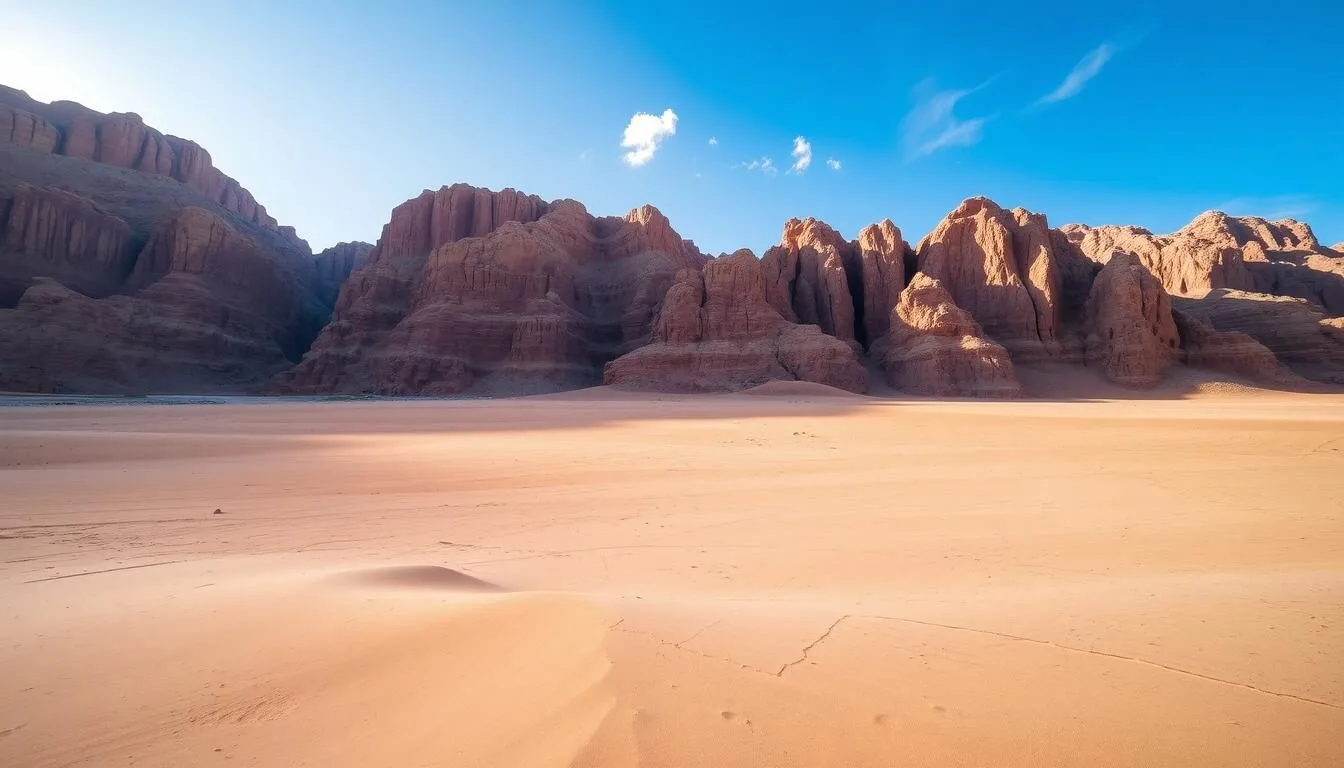✓ Accommodations✓ Flights✓ Rental Cars✓ Tours & Activities
You’ve likely seen it on the big screen – the breathtaking landscape that played a starring role in films like The Martian and Star Wars. This is Wadi Rum, a desert realm in Jordan that’s as surreal as it is beautiful.
Covering over 720 km², this protected UNESCO site is a marvel of nature, featuring towering rock formations, red sand dunes, and ancient inscriptions. As you immerse yourself in this otherworldly experience, you’ll discover a different pace of time, one that allows you to fully appreciate the natural wonders and rich Bedouin culture.
Ready to explore this Martian landscape on Earth? Let’s dive into the top experiences that’ll make your visit to Wadi Rum unforgettable.
Discovering the Magic of Wadi Rum
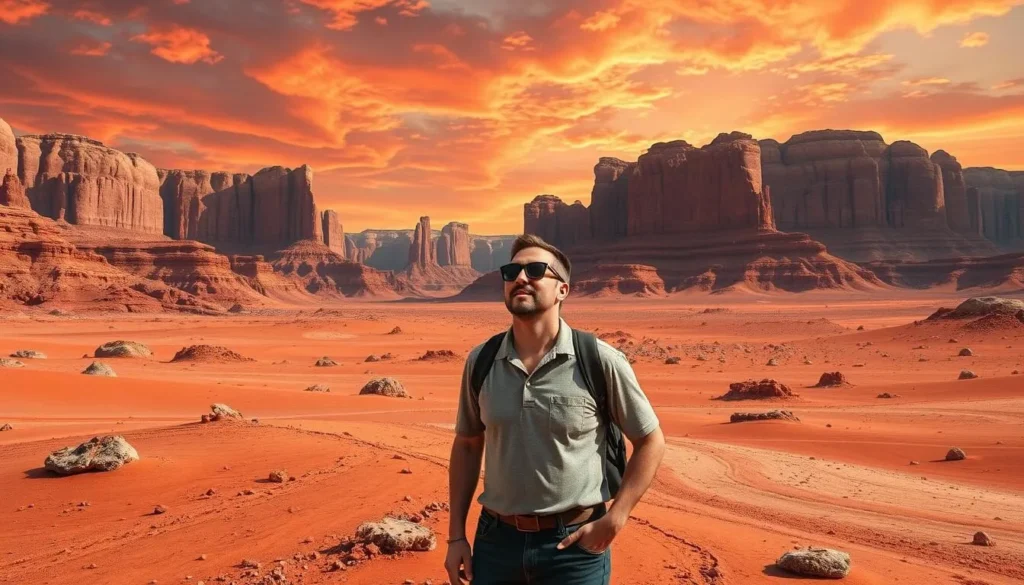
The majestic landscape of Wadi Rum, with its rust-red sands and towering sandstone mountains, invites you to explore its untouched beauty. Located in the heart of Jordan, this captivating destination promises adventure and unique natural beauty. As you venture into Wadi Rum, you’ll be struck by its surreal landscape, which has been shaped over millions of years.
Wadi Rum stands apart from other desert destinations with its distinctive combination of rust-red sands and dramatic sandstone mountains that rise majestically from the desert floor. The landscape features a fascinating geological history – what you see today as a dry desert was once actually the bottom of an ancient ocean, contributing to its unique rock formations and terrain.
Key Highlights of Wadi Rum:
- Wadi Rum’s unique landscape is characterized by its rust-red sands and dramatic sandstone mountains.
- The desert’s geological history is fascinating, with evidence of being an ancient ocean bed.
- You’ll find evidence of human history spanning thousands of years, from ancient Nabatean petroglyphs to sites associated with Lawrence of Arabia and the Great Arab Revolt.
- The changing colors of the desert throughout the day create a photographer’s paradise.
- Exploring Wadi Rum offers a perfect balance of adventure and tranquility.
- The desert’s unique characteristics have made it a favorite filming location for movies depicting alien planets.
As you explore Wadi Rum, you’ll have the opportunity to experience the timeless beauty of this protected wilderness area. The desert’s unique characteristics make it an ideal destination for those seeking adventure and tranquility. Whether you’re interested in history, nature, or simply relaxing in a beautiful setting, Wadi Rum has something to offer.
The ever-changing colors of the desert sky, coupled with the majestic sandstone formations, create a truly unforgettable experience. As the sun rises and sets, the sandstone cliffs glow in vibrant hues of orange, red, and purple, making it a paradise for photographers and nature lovers alike.
Stay in a Desert Dome or Bubble Tent
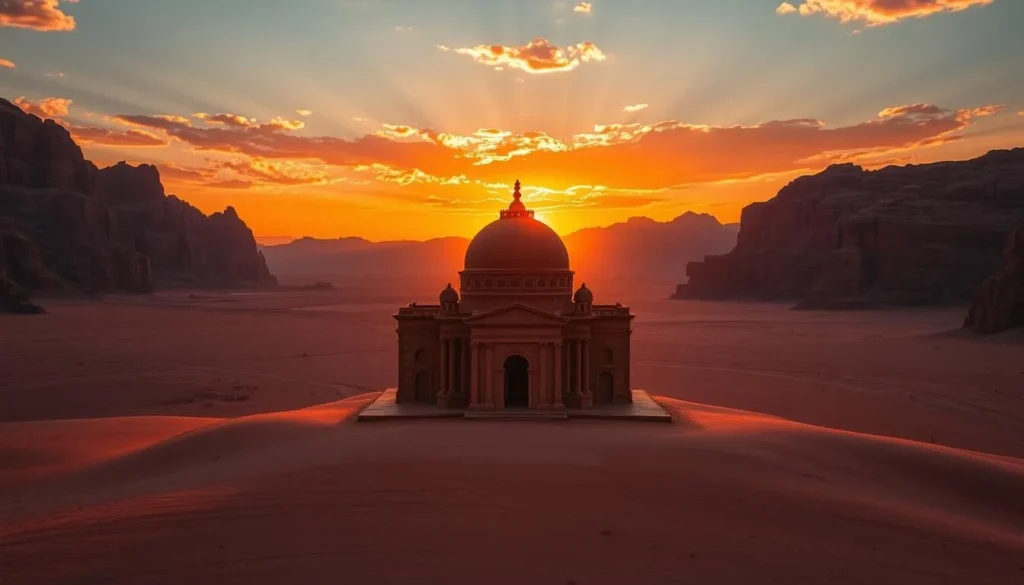
One of the most unforgettable experiences in Wadi Rum is staying in a bubble tent or desert dome, where the night sky is your canopy. These extraordinary accommodations are dotted across the vast desert landscape, offering a luxurious camping experience that blends seamlessly with the natural environment.
The bubble tents in Wadi Rum are designed to provide an unobstructed view of the starry night sky from the comfort of your bed. These futuristic-looking structures are strategically placed to ensure privacy while maximizing the panoramic views of the surrounding desert landscape.
Luxury Amenities in these desert domes include comfortable beds, private bathrooms, and sometimes even air conditioning or heating, depending on the season. The transparent ceiling of the bubble tents creates an unparalleled stargazing experience, allowing you to fall asleep under a blanket of stars without dealing with the elements.
Some of the popular bubble tent camps in Wadi Rum include Wadi Rum Night Luxury Camp, UFO Luxotel, Wadi Rum Bubble Luxotel, and Memories Aicha Luxury Camp. Each of these camps offers a unique take on the desert glamping experience, making your stay in Wadi Rum truly special.
It’s essential to book these accommodations well in advance, especially during peak tourist seasons, as they have become increasingly popular through social media exposure. Whether you’re looking for a romantic getaway or an adventurous escape, staying in a desert dome or bubble tent in Wadi Rum is an experience you won’t soon forget.
Experience a Jeep Tour Through the Desert Landscape
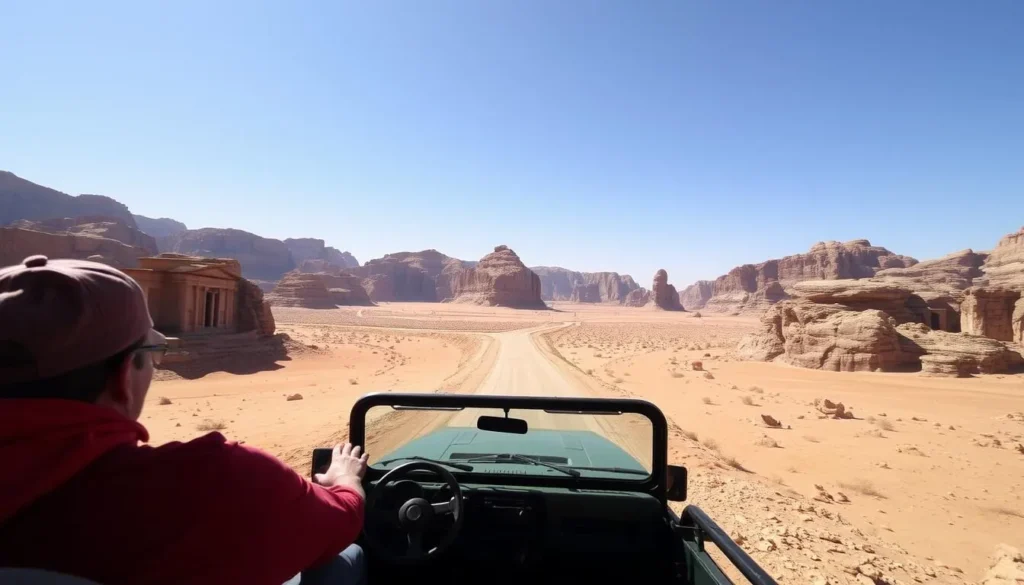
Embark on an unforgettable adventure through Wadi Rum’s breathtaking desert landscape with a thrilling jeep tour. A jeep tour is the most practical and exhilarating way to explore the vast terrain of Wadi Rum, allowing you to witness its majestic beauty up close. You’ll traverse through endless sand dunes, narrow canyons, and hidden valleys, making your way across the vast open space, stopping to admire ancient rock formations and their inscriptions.
Your experienced Bedouin guide will take you to many iconic photo spots, movie scenes, and hidden gems, sharing stories and knowledge about the desert’s history and ecology. You’ll spot camels roaming through the desert, thousand-year-old Nabatean petroglyphs carved into the rocks, and local Bedouin camps offering souvenirs and fresh tea.
Popular Stops on Jeep Tours
Some of the most popular stops on jeep tours in Wadi Rum include the Seven Pillars of Wisdom, named after T.E. Lawrence’s autobiography, Um Frouth Rock Arch, and Khazali Canyon with its ancient inscriptions. You’ll also visit various sand dunes perfect for panoramic views, taking in the breathtaking beauty of the desert landscape.
- The Seven Pillars of Wisdom, a significant landmark related to Lawrence of Arabia’s story.
- Um Frouth Rock Arch, a natural rock formation and iconic photo spot.
- Khazali Canyon, known for its ancient inscriptions and historical significance.
Best Time for Jeep Tours
The best times for jeep tours in Wadi Rum are early morning and late afternoon. The soft light and cooler temperatures of the early morning make it an ideal time for exploration, while the late afternoon offers the magical experience of watching the sunset over the desert landscape. It’s advisable to avoid the intense midday heat between 11 am and 3 pm.
Most tours include stops at Bedouin hospitality tents where you’ll be offered traditional sweet tea and the opportunity to purchase handcrafted souvenirs directly from local artisans. With a jeep tour, you’ll experience the vast and varied beauty of Wadi Rum’s desert landscape.
Spend a Night in a Traditional Bedouin Camp
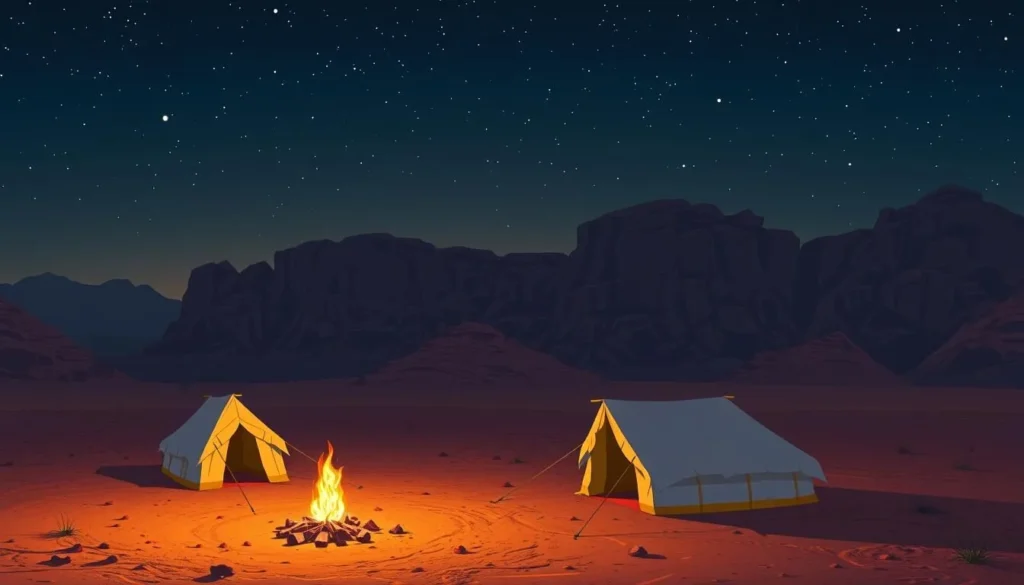
Immersing yourself in the authentic Bedouin lifestyle is possible by spending a night at a traditional desert camp in Wadi Rum. One of the best and most unique things to do in Wadi Rum, Jordan, is to experience the true Bedouin lifestyle by savoring the silence of the desert while you huddle around a cozy campfire under a sky full of stars.
These traditional yet comfortable camps offer a glimpse into authentic desert living. Cozy tents in vibrant colors protect the Bedouins from the intense sun rays during the day. At night, soak up the warm hospitality and delicious cuisine of the camp. Listen to the beautiful songs played after your Zarb dinner before settling into a comfortable bed and watching a starlit spectacle play overhead.
Top Bedouin Camps in Wadi Rum
Spending a night in a traditional Bedouin camp offers an authentic cultural experience that connects you with the desert’s nomadic heritage and the hospitality for which Bedouins are renowned. Some of the top Bedouin camps in Wadi Rum include:
- Bedouin Directions Camp
- Wadi Rum Backpacker Camp
- Milky Way Bedouin Camp
- Rahayeb Desert Camp
These camps typically feature traditional goat-hair tents arranged around a central communal area where guests gather in the evening for meals, music, and storytelling around a campfire. Unlike luxury bubble tents, traditional camps focus on cultural authenticity while still providing comfortable accommodations with proper beds, blankets, and basic amenities.
The evening experience at a Bedouin camp typically includes traditional music performances, where guides share songs passed down through generations, creating an immersive cultural atmosphere under the stars. Most camps are strategically positioned in secluded locations between towering rock formations, providing both protection from the elements and spectacular scenic surroundings.
The communal nature of Bedouin camps creates opportunities to connect with fellow travelers and your Bedouin hosts, adding a rich social dimension to your desert experience. In the morning, you’ll wake up to the sounds of the birds that live between the rocks, making for a serene and memorable conclusion to your night under the desert sky.
Wadi Rum, Jordan: Best Things to Do for Adventure Seekers
For those seeking adventure, Wadi Rum is a paradise that offers a myriad of thrilling activities. The desert landscape, with its towering sandstone mountains and vast expanses of sand, provides a unique backdrop for a variety of adrenaline-pumping experiences.
Wadi Rum is not just about scenic beauty; it’s an adventure playground. Whether you’re looking to sandboard down massive dunes, climb the rugged rock formations, or hike through the scenic canyons, Wadi Rum has something for every kind of adventure enthusiast.
Sandboarding Down the Dunes
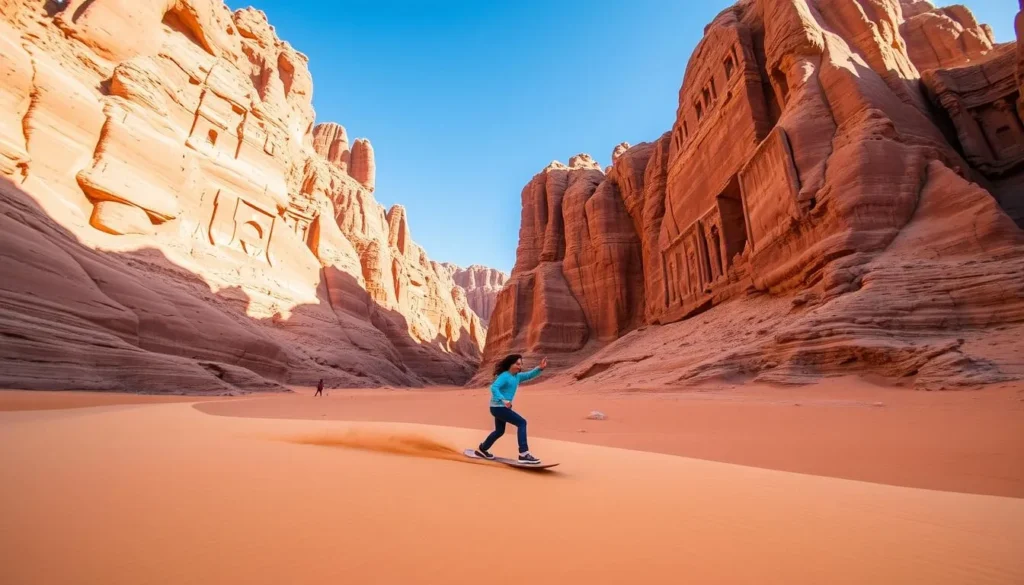
Sandboarding in Wadi Rum is an exhilarating experience that lets you glide down the soft, golden slopes of the desert’s largest dunes. The activity is similar to snowboarding but on sand, and most sandboard tours can be organized through your Bedouin camp or accommodation.
The best time for sandboarding is early in the morning when the sand is cooler and more compact, making for smoother rides. This activity is a must-try for adventure seekers visiting Wadi Rum.
Rock Climbing and Hiking Opportunities
Image of rock climbing in Wadi Rum
For those who enjoy rock climbing, Wadi Rum offers hundreds of established routes on its sandstone cliffs and formations. Climbers from around the world are drawn to Wadi Rum’s unique challenges, making it a hub for rock climbing enthusiasts.
Hiking is another way to experience the beauty of Wadi Rum. Trails range from easy walks through scenic canyons to more challenging multi-day treks across the desert. Popular hiking routes include the trail to Burdah Rock Bridge and Abu Khashaba Canyon. A local guide is essential for navigation and safety.
Go Stargazing Under the Desert Sky
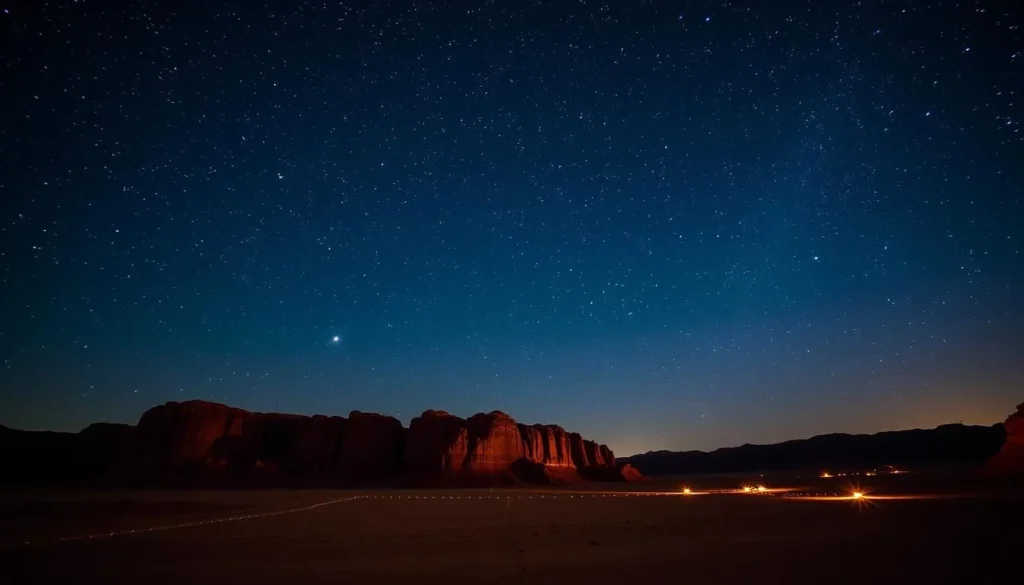
Wadi Rum’s remote location and lack of light pollution make it an ideal spot for stargazing. With an altitude of over 1000m, the desert sky above Wadi Rum is incredibly clear, offering a breathtaking view of the stars.
The experience of stargazing in Wadi Rum is truly magical. Spread out a blanket on the soft desert sand, and you’ll be gazing up at a night sky filled with thousands of stars. The Milky Way is visible in stunning clarity, along with countless stars, planets, and even meteor showers during certain times of the year.
Guided Stargazing Experiences are available at many desert camps in Wadi Rum. Knowledgeable Bedouin hosts will guide you through the night sky, sharing ancient stories and myths while pointing out celestial wonders. For astronomy enthusiasts, specialized stargazing tours are available with expert guides who bring telescopes to explore the sky further.
To make the most of your stargazing experience, allow your eyes to adjust to the darkness for at least 20-30 minutes. Bring warm layers, as desert temperatures drop significantly at night, even in summer. The contrast between the silence of the desert and the vast canopy of stars creates a profound sense of perspective, often described as a spiritual or meditative experience.
If you’re staying in a bubble tent or desert dome, you can enjoy this celestial display from the comfort of your bed, falling asleep under the stars without braving the cooler night temperatures.
Experience Hot Air Ballooning Over the Desert
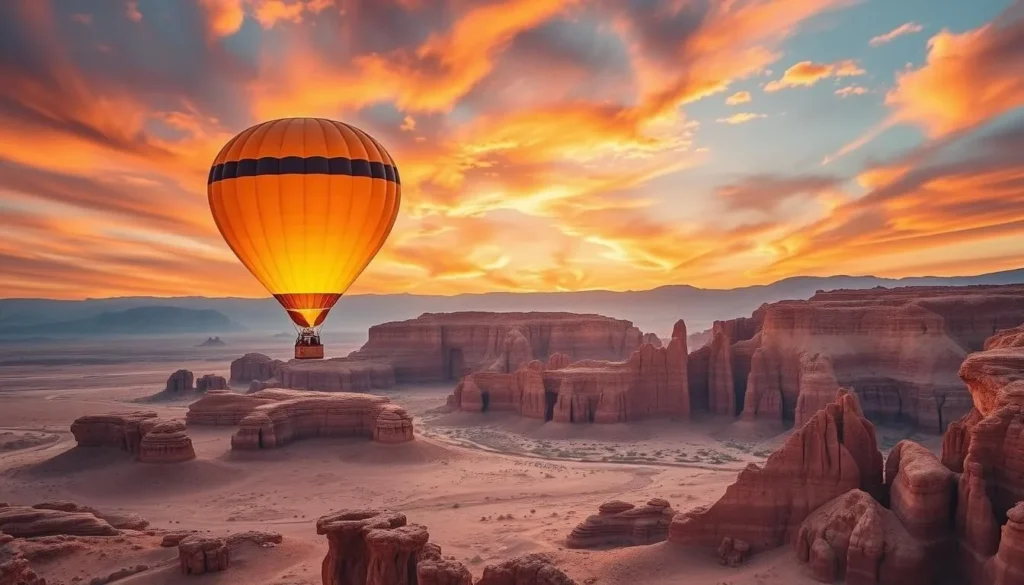
Imagine soaring above Wadi Rum’s breathtaking landscape in a hot air balloon. You’ll experience the vast desert expanse from a unique perspective, with the rusty-red sands and towering rock formations stretching out as far as the eye can see.
Hot air ballooning offers a breathtaking perspective of Wadi Rum’s vast desert landscape that simply can’t be experienced any other way. You’ll witness the true scale and patterns of this magnificent terrain, with the desert’s rock formations, canyons, and dunes creating natural patterns that are impossible to fully appreciate from ground level.
A typical hot air balloon experience lasts about 1.5 hours, with the actual flight time being approximately 45-60 minutes depending on wind conditions. The hot air balloons usually take off around sunrise when the winds are calmer, and the light creates a magical golden glow across the rusty-red sands and towering rock formations.
The experience includes transportation to and from the launch site, a safety briefing, the balloon flight itself, and often a light breakfast or refreshments upon landing. While premium-priced at around 140 JD (200 USD) per person, this once-in-a-lifetime experience provides unparalleled photo opportunities and a serene floating sensation above one of the world’s most unique landscapes.
To ensure a smooth experience, it’s recommended to book your hot air balloon ride in advance as they’re weather-dependent and operate with limited capacity. Most camps or hotels can arrange this activity for you, making it easy to add this unforgettable experience to your Wadi Rum itinerary.
Enjoy a Traditional Bedouin Dinner (Zarb)
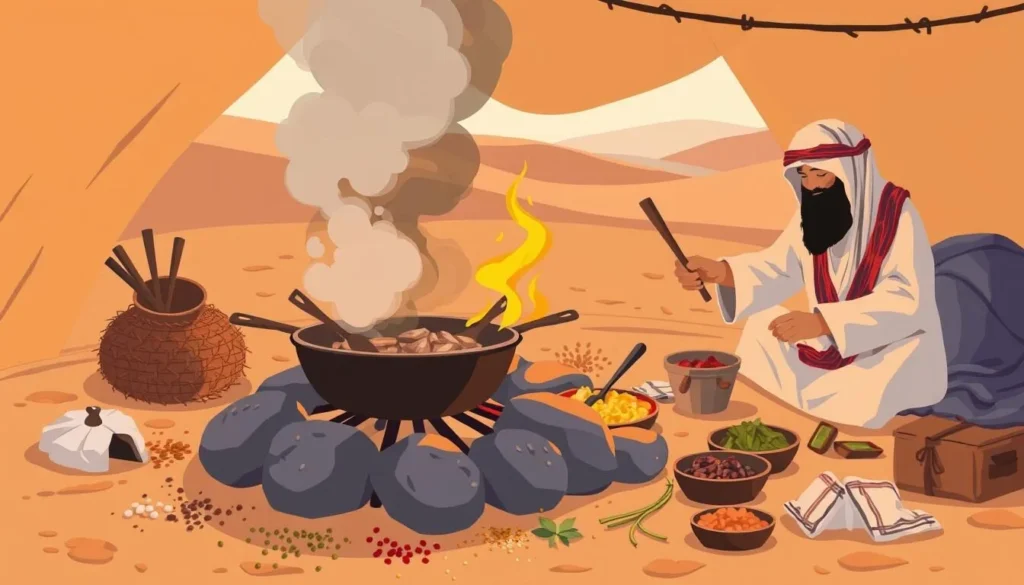
Savoring a Zarb dinner under the starry desert sky is a culinary highlight of any Wadi Rum visit. As the sun sets over the rugged mountains, the camp’s chef prepares a delicious Zarb dinner, a traditional Bedouin meal that’s both flavorful and culturally enriching.
The Zarb dinner is a unique underground cooking method where lamb, chicken, and locally grown vegetables are slow-cooked in an earth oven dug into the desert sand. You can watch as your Bedouin hosts expertly dig the pit, arrange hot coals, and lower multi-tiered metal racks of food before covering everything with sand to create a natural pressure cooker.
After several hours of cooking, the unveiling of the Zarb is a ceremonial moment in camp. The sand is brushed away to reveal aromatic, perfectly tender meat and vegetables. The meal is typically served with traditional sides including hummus, fresh salads, flatbread, and fragrant rice, creating a feast that’s enjoyed communally.
Following dinner, most camps offer traditional Bedouin tea, sometimes shisha (water pipe), and often music and storytelling around the campfire. This creates a complete cultural immersion, allowing you to soak up the warm hospitality of the beautiful and ancient Bedouin culture.
The combination of delicious food, cultural exchange, and the magical setting under the stars makes the Zarb dinner experience one of the most memorable aspects of staying at a Bedouin camp in Wadi Rum. It’s an experience that not only delights your taste buds but also leaves you with lasting memories of your time in this breathtaking desert landscape.
Explore Ancient Rock Formations and Natural Arches
Exploring Wadi Rum reveals a world of ancient rock formations and natural arches, sculpted by time and weather. As you journey through this breathtaking landscape, you’ll encounter some of the most impressive geological formations on the planet. The unique combination of sandstone and granite has created a landscape that seems almost deliberately sculpted by an artist’s hand.
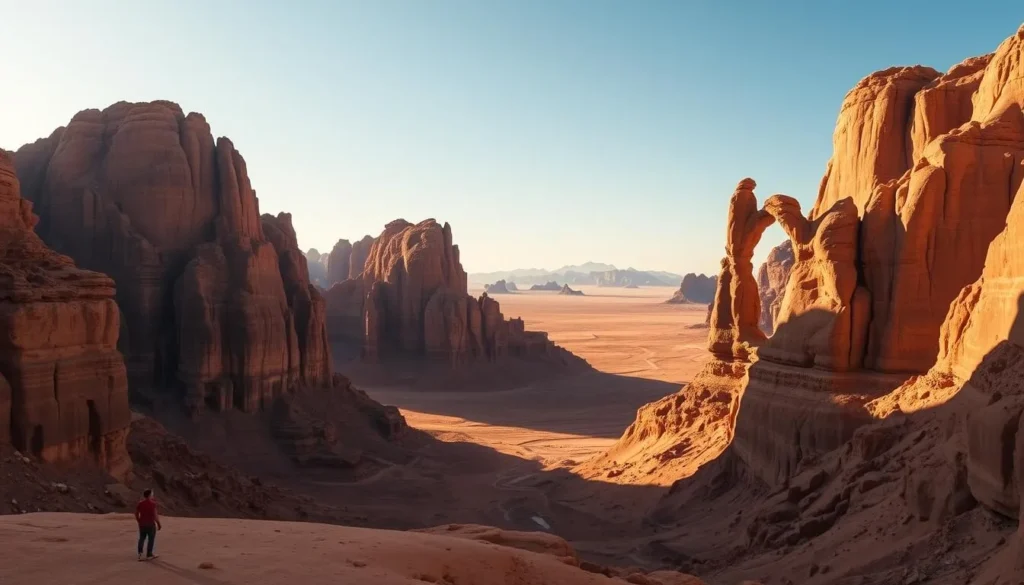
Wadi Rum’s iconic rock formations and natural arches are a result of millions of years of erosion. The area is home to numerous formations that have been shaped into unique shapes and structures. One of the most photographed is the Seven Pillars of Wisdom.
The Seven Pillars of Wisdom
The Seven Pillars of Wisdom is a massive mountain with seven distinct peaks, named after T.E. Lawrence’s autobiography. Visible from the visitor center, it’s a striking sight that has captivated visitors for decades. This iconic formation is a must-see when exploring Wadi Rum.
Um Frouth Rock Arch
Um Frouth Rock Arch is another natural wonder, offering visitors the chance to climb up and through this natural bridge. The panoramic views of the surrounding desert are simply spectacular, making it a popular stop on jeep tours. As you stand in the center of this arch, you’ll feel as though you’re in a truly unique and isolated spot.
Khazali Canyon and Ancient Inscriptions
Khazali Canyon houses some of Wadi Rum’s most significant ancient inscriptions, featuring Nabatean, Thamudic, and Islamic carvings that date back thousands of years. These inscriptions provide fascinating insights into the people who traversed these desert routes throughout history. The narrow fissure in the mountain contains depictions of humans, animals, and ancient writing systems preserved in the sandstone.
Other notable formations in Wadi Rum include Mushroom Rock, Burdah Rock Bridge, and Little Bridge, each offering unique perspectives on the desert’s geological wonders. The varying colors and textures of these formations throughout the day make them popular photography subjects, with the warm light of sunrise and sunset bringing out rich red and orange hues in the sandstone.
Visit Historic Sites and Petroglyphs
As you explore the vast expanse of Wadi Rum, you’ll uncover a rich tapestry of history and culture. Beyond its natural beauty, Wadi Rum is rich with historical significance, containing evidence of human habitation dating back 12,000 years through rock art, inscriptions, and archaeological sites.
The area is home to numerous historic sites, including Lawrence of Arabia’s House, a partially preserved Nabatean structure where T.E. Lawrence reportedly stayed during the Arab Revolt against the Ottoman Empire in the early 1900s. While historians debate how much time Lawrence actually spent in Wadi Rum, his connection to the area has been immortalized through the classic film “Lawrence of Arabia” and remains a significant draw for visitors.
Lawrence of Arabia’s House and Spring
Lawrence Spring is another site associated with the British officer, featuring a small water source that has been vital for desert travelers for centuries. The spring is located near the entrance of Wadi Shallalah, and visitors can spot the water tank near the entrance to find the spring. Lawrence of Arabia’s House is also a popular stop, with a great tea stop, cute kittens, and a wonderful viewpoint from the adjacent rock face.
| Historic Site | Description | Significance |
|---|---|---|
| Lawrence of Arabia’s House | Nabatean structure where T.E. Lawrence reportedly stayed | Connection to the Arab Revolt and the film “Lawrence of Arabia” |
| Lawrence Spring | Small water source vital for desert travelers | Historical significance as a vital water source |
Nabatean Petroglyphs
Throughout Wadi Rum, you’ll find thousands of Nabatean petroglyphs – rock carvings created by the same civilization that built Petra – depicting humans, animals, hunting scenes, and various symbols. These petroglyphs served as communication tools between nomadic groups, marking water sources, territorial boundaries, and sharing information about conditions ahead for those traveling the ancient trade routes.
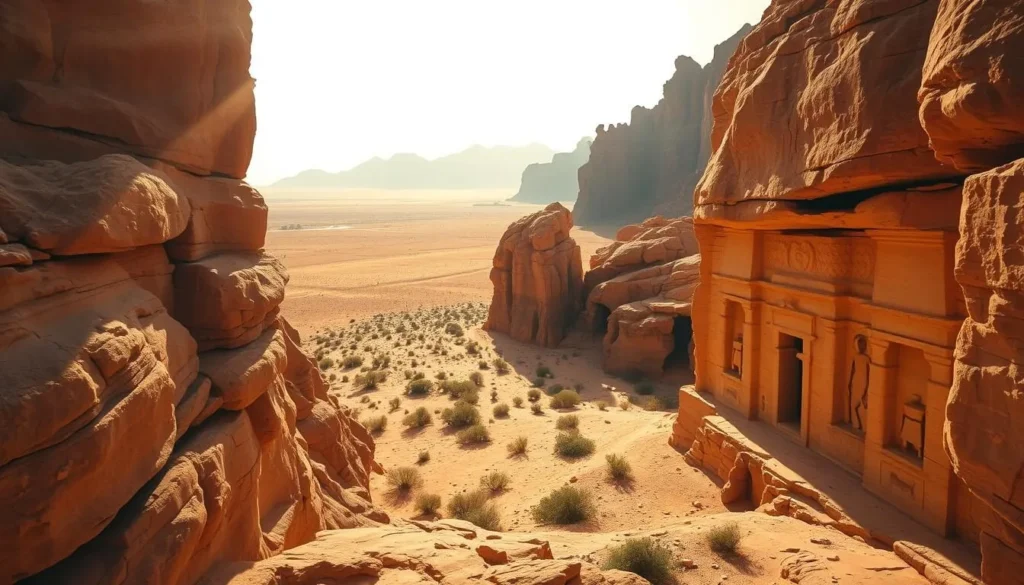
The preservation of these carvings in the dry desert climate provides a remarkable window into ancient desert life and the sophisticated communication systems developed by early civilizations in this challenging environment.
How Many Days to Spend in Wadi Rum
Many travelers wonder how to make the most of their time in Wadi Rum, Jordan. The ideal duration depends on your overall Jordan itinerary and what you wish to experience. While many visit Wadi Rum on a one-day tour from destinations like Amman, combining it with Petra, there are numerous activities that make it worthwhile to spend at least two days here.
From personal experience, a half-day jeep tour (4-5 hours) followed by a night in a Bedouin camp and departure the next morning provides a comprehensive experience, covering major sites and cultural immersion. For most visitors, one night and one full day is considered optimal, allowing you to enjoy both sunset and sunrise in the desert, participate in a jeep tour, and savor evening cultural experiences.
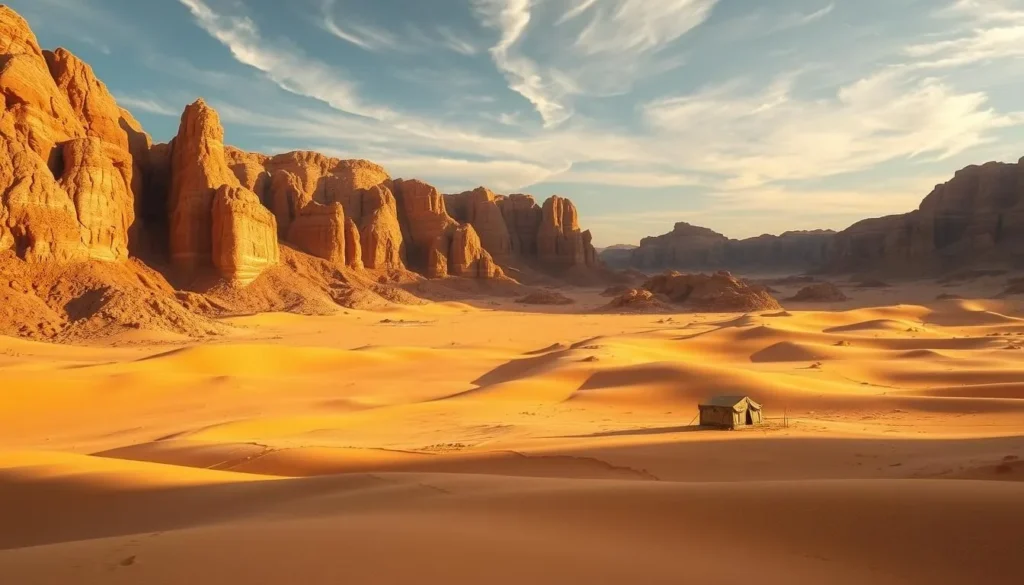
For those with limited time, a day trip from Aqaba or Petra is feasible, but you’ll miss the enchanting experience of spending a night under the stars. If you’re interested in specialized activities like extended hiking or rock climbing, or prefer a relaxed pace, two nights in Wadi Rum can be beneficial.
When planning your Jordan itinerary, consider that Wadi Rum pairs well with visits to Petra and Aqaba, forming a logical southern Jordan circuit that many travelers complete in 4-5 days. For photography enthusiasts, an overnight stay is essential to capture the golden light of sunset and sunrise.
In conclusion, while the duration of your stay in Wadi Rum depends on your interests and schedule, a well-planned itinerary ensures a memorable experience in this breathtaking desert landscape.
Best Time to Visit Wadi Rum
When planning your trip to Wadi Rum, understanding the best time to visit is crucial for a memorable experience. The desert landscape offers a unique experience throughout the year, but certain times are more favorable than others.
Wadi Rum, Jordan, is known for its extreme desert climate, with very hot summers and cool winters. The best seasons to visit are spring (March-May) and fall (September-November), when the temperatures are moderate, making it ideal for exploration and outdoor activities.
Weather and Seasons in the Desert
The desert weather in Wadi Rum can be quite unpredictable, with significant temperature variations between day and night across all seasons. In the spring, the landscape is occasionally adorned with desert wildflowers after winter rains, creating a breathtaking contrast against the red sands.
Summer brings extremely high temperatures, often reaching 40-42°C (104-108°F), making midday activities challenging. In contrast, winter days are pleasant, around 15-20°C (59-68°F), but nights can drop to near-freezing temperatures, requiring warm clothing.
Peak and Off-Peak Times
Peak tourist seasons in Wadi Rum coincide with spring and fall, offering comfortable temperatures and ideal conditions for exploration. However, this means more crowds and higher prices for accommodations and tours.
Visiting during the off-peak season, like winter, can offer cost savings and a more serene experience, but it requires preparation for the cold nights. It’s also worth noting that during Ramadan, some services may be limited during the day.
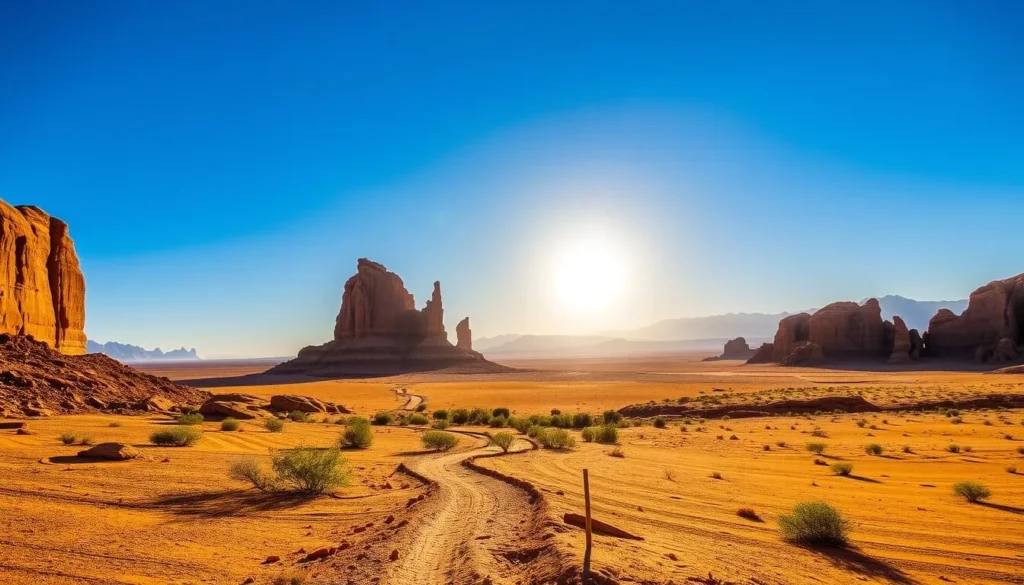
In conclusion, the best time to visit Wadi Rum depends on your preferences and what you want to experience. Whether you choose the mild weather of spring and fall or the unique experiences of summer and winter, Wadi Rum is sure to leave a lasting impression.
How to Get to Wadi Rum
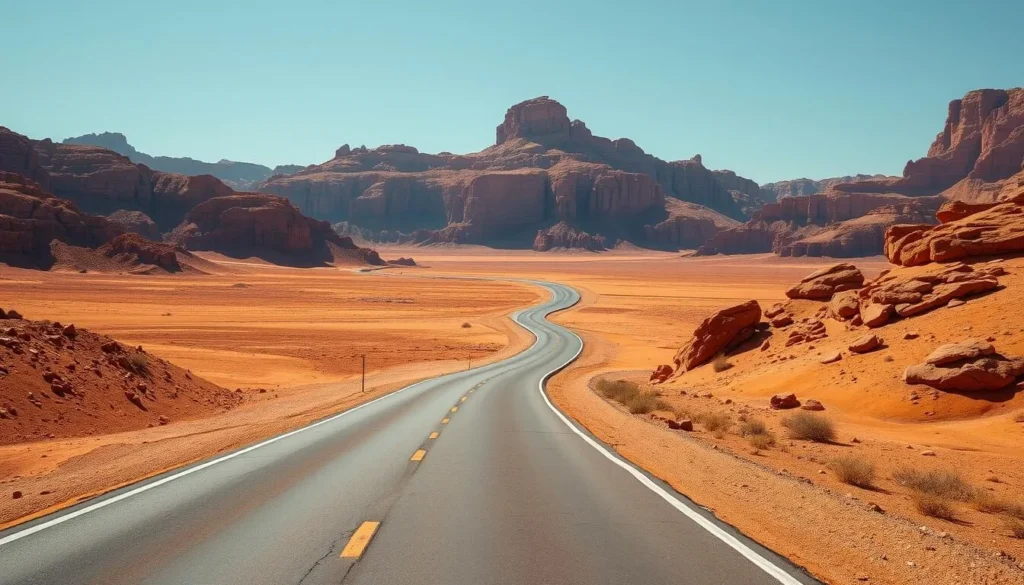
Reaching Wadi Rum, one of Jordan’s most stunning natural wonders, is relatively simple. The desert landscape is accessible by road, and most camps are just a short distance off the main road.
There are several ways to get to Wadi Rum, depending on your starting point and travel preferences. The most popular options include renting a car, hiring a private driver or taxi, or joining an organized tour.
From Amman
The journey from Amman to Wadi Rum takes approximately 4 hours by car, covering a distance of about 313 km along the Desert Highway. Renting a car gives you the flexibility to create your own itinerary and explore other attractions in Jordan.
From Petra
If you’re coming from Petra (Wadi Musa), Wadi Rum is just 2 hours away, covering a distance of 107 km. This makes it a natural next stop on most Jordan itineraries after exploring the ancient city.
From Aqaba
Aqaba is the closest major access point to Wadi Rum, with a travel time of just 1 hour, covering 56 km. This makes it an excellent base for day trips or the next destination after your desert experience.
Regardless of your starting point, you’ll need to park your vehicle at the designated lot in Wadi Rum Village and transfer to a 4×4 vehicle operated by your camp or tour provider, as personal vehicles are not permitted in the protected desert area.
All visitors must stop at the Wadi Rum Visitor Center to purchase entry tickets (5 JD) or have their Jordan Pass stamped before proceeding to the village and desert.
What to Pack for Your Wadi Rum Adventure
Preparing for your Wadi Rum adventure requires careful packing to ensure a comfortable and enjoyable experience. Whether you’re staying overnight in a Bedouin camp or just visiting for the day, having the right gear is crucial.
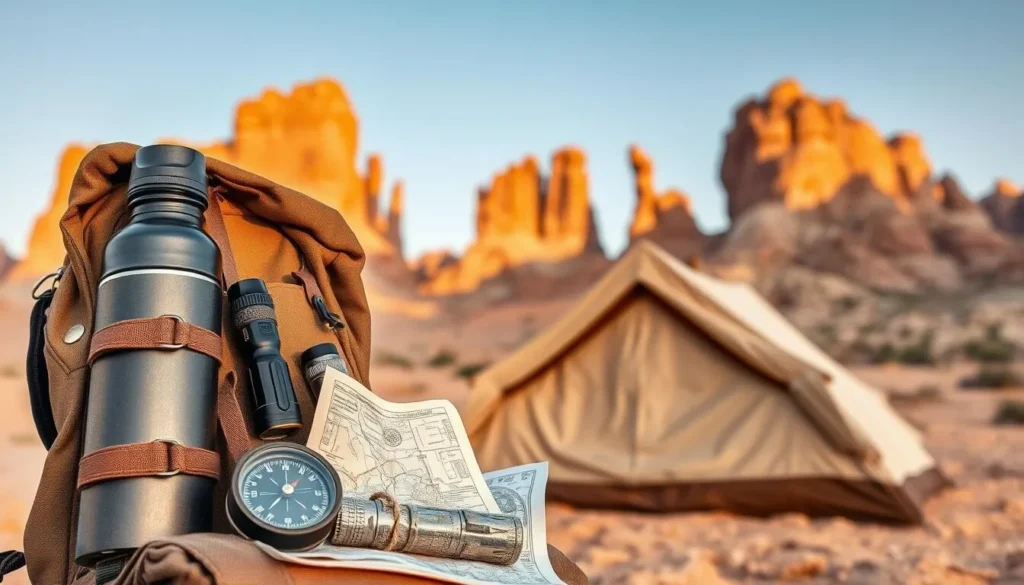
Essential Items
For a comfortable and safe experience in Wadi Rum, it’s essential to pack a few key items. First, a headlamp or flashlight is a must, even if your camp provides lighting, as it can be a lifesaver after dark. A power bank to keep your devices charged is also vital, given the limited power outlets in the desert.
Other essential items include sunscreen with a high SPF, sunglasses, and a wide-brimmed hat to protect you from the harsh desert sun. Staying hydrated is also crucial, so bring a refillable water bottle. Most camps and tours will provide drinking water, but it’s always a good idea to have your own container.
- A camera with extra batteries and lens cleaning equipment to capture the breathtaking scenery without worrying about your gear.
- A lightweight tripod for photography enthusiasts who want to capture the night sky.
Clothing Recommendations
When it comes to clothing, the key is layers. The desert temperature can fluctuate significantly between day and night, so it’s essential to be prepared. For daytime, opt for lightweight, breathable fabrics that protect you from the sun.
Loose-fitting long-sleeved shirts and pants are recommended for better sun protection and to respect local cultural norms. For footwear, sturdy, closed-toe shoes with good traction are ideal for climbing rock formations and walking in the sand.
Don’t forget a scarf or shemagh, a traditional Middle Eastern headscarf that serves multiple purposes: sun protection, warmth in the evening, and protection from dust during jeep rides. Your guide can help you style it to protect your hair from the wind and sand.
Practical Tips for Visiting Wadi Rum
When planning your trip to Wadi Rum, there are several practical tips to keep in mind to ensure a memorable and enjoyable experience. Wadi Rum offers a range of differently-priced options for accommodations and activities, allowing you to choose campsites, hostels, and local eateries for a more affordable desert experience.
Entry Fees and Jordan Pass
Understanding the costs associated with visiting Wadi Rum is crucial for planning. The entry fee to Wadi Rum is 5 JD (approximately $7 USD) per person, but this fee is waived if you have purchased the Jordan Pass. The Jordan Pass is highly recommended as it includes entry to over 40 sites, including Petra, and covers your tourist visa fee, making it an excellent value.
| Pass Type | Entry Fee | Additional Benefits |
|---|---|---|
| Jordan Pass | Included | Entry to over 40 sites, tourist visa fee |
| Individual Entry | 5 JD ($7 USD) | None |
Safety Considerations
Safety should be your top priority when exploring Wadi Rum. It’s strongly advised against exploring the desert independently without a guide due to the vast landscape and extreme temperatures. Always carry more water than you think you’ll need, wear sun protection, and avoid extensive outdoor activities during the hottest hours (11am-3pm).
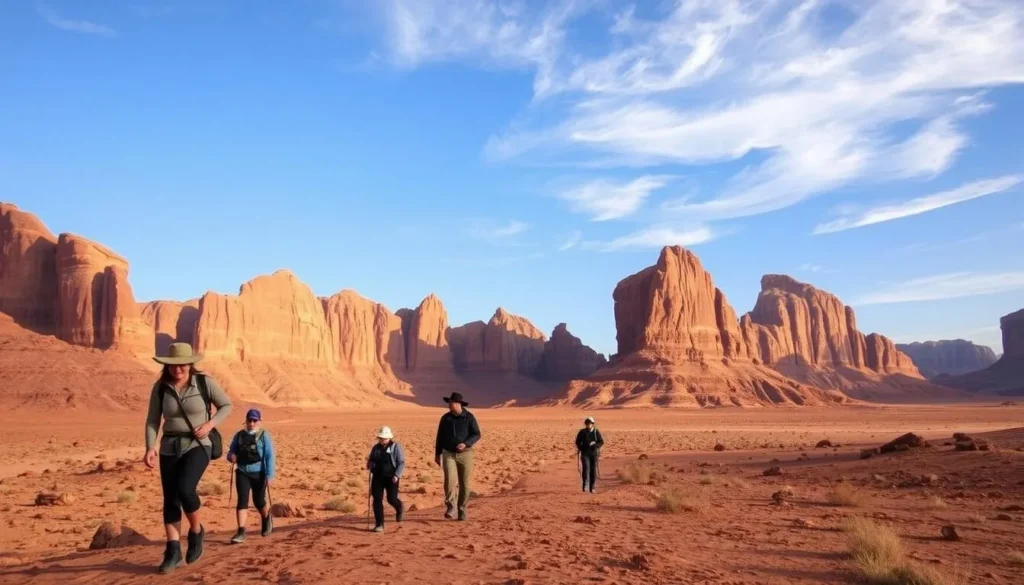
Respecting Local Culture
Respecting local customs is essential when staying at a Bedouin camp. Dress modestly by covering your shoulders and knees, ask permission before photographing people, and remove your shoes when entering tents if requested. Tipping is also customary in Jordan; plan to tip your jeep driver/guide and camp staff accordingly.
By following these practical tips, you can ensure a safe, enjoyable, and culturally respectful visit to Wadi Rum. Be mindful of your surroundings, respect local customs, and stay informed to make the most of your desert adventure.
Conclusion: The Unforgettable Experience of Wadi Rum
Your adventure in Wadi Rum comes to a close, but the impact of its natural beauty and rich cultural heritage stays with you. The combination of otherworldly landscapes, ancient history, adventure activities, and cultural immersion creates memories that will linger long after you’ve left the red sands behind.
Wadi Rum offers an unforgettable experience that transcends typical tourism, connecting you with both the timeless beauty of nature and the rich cultural heritage of Jordan’s Bedouin communities. Whether you’ve spent one day or several in Wadi Rum, the desert’s unique character leaves an indelible impression – the vastness of the landscape, the silence of the dunes, and the brilliance of the night sky create a profound sense of perspective.
As you plan the rest of your Jordan itinerary, consider how Wadi Rum fits into your broader exploration of this fascinating country. The hospitality you’ll experience in Wadi Rum exemplifies the warmth of Jordanian culture, offering a genuine connection with local people that enriches your understanding of the region. Whatever activities you choose in Wadi Rum, you’ll leave with a deeper appreciation for both the natural world and the resilient people who have called this challenging landscape home for thousands of years.
The above is subject to change.
Check back often to TRAVEL.COM for the latest travel tips and deals.
